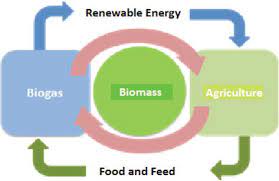
Science Project On Biogas For Class 9th
Introduction
In a world where our thirst for energy is ceaseless, and environmental concerns loom large, the quest for renewable energy sources becomes an imperative mission. Enter biogas, a compelling and eco-conscious energy solution that has emerged as a beacon of hope. It springs forth through a natural phenomenon called anaerobic digestion, where organic matter undergoes transformation in the absence of oxygen. The primary constituents of this green marvel are methane (CH4) and carbon dioxide (CO2), accompanied by subtle traces of other gases.
The allure of biogas lies in its remarkable capacity to offer clean, renewable energy while also tackling pressing issues such as waste management and the energy needs of rural areas. Within the confines of this project, we embark on a journey into the realm of biogas, unearthing its genesis, advantages, and versatile applications.
Need of Biogas
Biogas technology isn’t just another entry in the energy ledger; it’s a multi-faceted answer to several urgent demands:
- Renewable Energy: As our unrelenting reliance on fossil fuels continues to exacerbate climate change and deplete finite resources, biogas emerges as a beacon of sustainability. It can seamlessly substitute conventional fossil fuels across diverse applications, thus mitigating greenhouse gas emissions and curtailing our carbon footprint.

- Waste Management: The conundrum of organic waste, including animal excreta, agricultural residues, and kitchen leftovers, perpetually haunts our environmental conscience. Biogas technology, however, waves a magic wand over this organic chaos, converting it into a precious resource and relieving us of the burdens of waste disposal.

- Rural Empowerment: In rural pockets where electricity access remains a luxury or an unreliable rarity, biogas emerges as a steadfast source of clean energy, illuminating homes and powering stoves for cooking. This leap in energy access translates to improved living standards and socio-economic advancement.

Method
The production of biogas unfolds through a meticulously orchestrated method known as anaerobic digestion, a symphony of sorts:
- Feedstock Preparation: The stage is set with organic waste materials—be it animal dung, crop residues, or kitchen refuse—gathered and prepared. Here, preparation often involves the art of chopping or grinding, enhancing the surface area for efficient digestion.
- Digestion: The prepared organic matter then finds its home within a sealed digester. Within this vessel, anaerobic bacteria work their invisible magic, diligently breaking down the organic matter, while concurrently birthing biogas as a valuable byproduct.
- Gas Collection: Biogas, predominantly rich in methane, ascends to the zenith of the digester, gracefully finding refuge in a gas holder or a dedicated storage tank.
- Gas Utilization: The treasure trove of biogas, now harnessed, finds purpose across various domains, including culinary exploits, ambient illumination, cozy heating, and as a dependable fuel source for engines and generators.
Observation
In the theatre of biogas production, keen observation unravels the captivating metamorphosis of organic waste into boundless energy. Discerning moments include:
- Gas Accumulation: Time unveils the gradual rise in biogas within the gas holder or storage tank, each increase in pressure signaling the birth of methane.
- Waste Evolution: As digestion marches on, you’ll notice a gradual diminishment in the volume and consistency of the organic waste. This transformation signifies the conversion of waste into simpler compounds.
- Temperature and Gas Prowess: Monitoring the temperature within the digester serves as a barometer of digestion efficiency. Elevated temperatures tend to quicken the pace of gas production.
Production
Feedstock Selection: The pivotal choice of organic feedstock is akin to selecting the ingredients for a culinary masterpiece. Materials like animal manure, crop residues, food waste, and even sewage sludge are potential candidates. This selection influences not only the yield but also the unique composition of our coveted biogas.
Anaerobic Digestion: At the heart of biogas production lies a symphony of microscopic maestros. These bacteria perform a ballet of sorts, breaking down complex organic molecules into simpler compounds. The star performers are methane (CH4) and carbon dioxide (CO2), generated through an intricate biochemical ballet.
Environmental Factors: The stage is set by environmental factors. The temperature within the digester plays a pivotal role, with mesophilic digestion (around 35-40°C) and thermophilic digestion (around 50-55°C) being preferred temperature ranges for optimal biogas production. pH levels, typically in the range of 6.5 to 7.5, ensure the harmony of this microbial orchestra.
Retention Time: Time is of the essence in our biogas production saga. The duration, known as retention time, determines the efficiency of gas production. Longer times allow the microbes ample moments to break down organic matter, contributing to a richer biogas yield.
Gas Collection: As our microbial performers continue their act, the biogas produced rises to claim its place at the top of the digester. A gas holder or storage tank serves as the grand stage where biogas is collected, ready for a controlled release and purposeful utilization.
Byproducts: Our biogas spectacle doesn’t end with gas alone. The process yields a valuable sidekick: digestate. This residue, nutrient-rich and brimming with potential, steps into the spotlight as an exceptional biofertilizer.
Natural Biogas and Manure Management Programme
Financial Support: The green revolutionaries behind the Natural Biogas and Manure Management Programs offer more than just ideals; they extend a helping hand with grants, subsidies, and financial incentives. These offerings help communities offset the initial costs of setting up their biogas digesters.
Technical Assistance: Knowledge is power, and these programs empower individuals and communities with training and technical support. It’s a curriculum designed to educate users on the fine art of operating and maintaining biogas systems.
Environmental Impact: The impact on the environment is a grand finale in itself. By converting organic waste into biogas, these programs substantially contribute to reducing methane emissions from waste. In this environmental ballet, air and water quality are in the spotlight.
Rural Empowerment: The story unfolds in rural landscapes, where access to clean energy was once a distant dream. With biogas, it becomes a reality. It’s a transformation that not only fuels stoves and illuminates homes but also fosters independence from traditional, often polluting fuel sources.
Society and Culture
Improved Living Standards: In rural areas, biogas isn’t just a utility; it’s a harbinger of improved living standards. It banishes indoor air pollution and ushers in a breath of fresh air.
Gender Equality: Women often take center stage in this cultural shift. Biogas technology empowers them by freeing up time spent collecting fuelwood and reducing exposure to harmful cooking smoke.
Sustainable Agriculture: The saga of biogas extends to the fields. Digestate, our nutrient-rich sidekick, steps in as a biofertilizer, enriching soil fertility and elevating crop yields. It’s a tale of sustainable agricultural practices.
Composition of Biogas in Percentage
The Composition: The composition of biogas reads like a chemical sonnet—about 60-70% methane (CH4), 30-40% carbon dioxide (CO2), with a dash of other gases, including hydrogen sulfide (H2S), water vapor (H2O), and nitrogen (N2). The feedstock and digestion conditions decide the exact recipe.
Conclusion: The Grand Finale
In the grand finale, biogas takes a bow as a versatile and sustainable energy source. Its production, a symphony of choices and environmental factors, is the conductor’s wand. Beyond clean energy, biogas waltzes through waste management conundrums and raises rural communities to new heights.
The Natural Biogas and Manure Management Programs are the unsung heroes, offering financial support, knowledge, and environmental stewardship. Societal and cultural transformations occur as biogas illuminates lives, empowers women, and nurtures sustainable agriculture.
The composition, primarily methane and carbon dioxide, underscores biogas’s potential as a green energy source. Embracing biogas isn’t just an energy choice; it’s a commitment to a cleaner environment, reduced greenhouse gas emissions, and a brighter future.
References
- “Biogas Production Handbook” by K. Johnsen and A. Björn.
- “Biogas Technology for Sustainable Development: A Comprehensive Review” by S. Yadav et al.
- “The Role of Biogas in Rural Energy Provision” by E. Grover-Silva and L. S. Roquim.
Acknowledgment
The stage wouldn’t be complete without acknowledging the contributions of those who guided and supported this project. My science teacher’s wisdom and my classmates’ spirited discussions added depth to this endeavor. Lastly, the authors and researchers whose work paved the way deserve our heartfelt gratitude.
Certificate of Completion
[Student’s Name][Class/Grade Level]This is to certify that I, [Student’s Name], a [Class/Grade Level] student, have successfully completed the project on “Biogas For Class 9th” The project explores the fundamental principles and key aspects of the chosen topic, providing a comprehensive understanding of its significance and implications.
In this project, I delved into in-depth research and analysis, investigating various facets and relevant theories related to the chosen topic. I demonstrated dedication, diligence, and a high level of sincerity throughout the project’s completion.
Key Achievements:
Thoroughly researched and analyzed Science Project On Biogas For Class 9th.
Examined the historical background and evolution of the subject matter.
Explored the contributions of notable figures in the field.
Investigated the key theories and principles associated with the topic.
Discussed practical applications and real-world implications.
Considered critical viewpoints and alternative theories, fostering a well-rounded understanding.
This project has significantly enhanced my knowledge and critical thinking skills in the chosen field of study. It reflects my commitment to academic excellence and the pursuit of knowledge.
Date: [Date of Completion]Signature: [Your Signature] [School/Institution Name][Teacher’s/Examiner’s Name and Signature]
In order to download the PDF, You must follow on Youtube. Once done, Click on Submit
Follow On YoutubeSubscribed? Click on Confirm
Download Science Project On Biogas For Class 9th PDF






